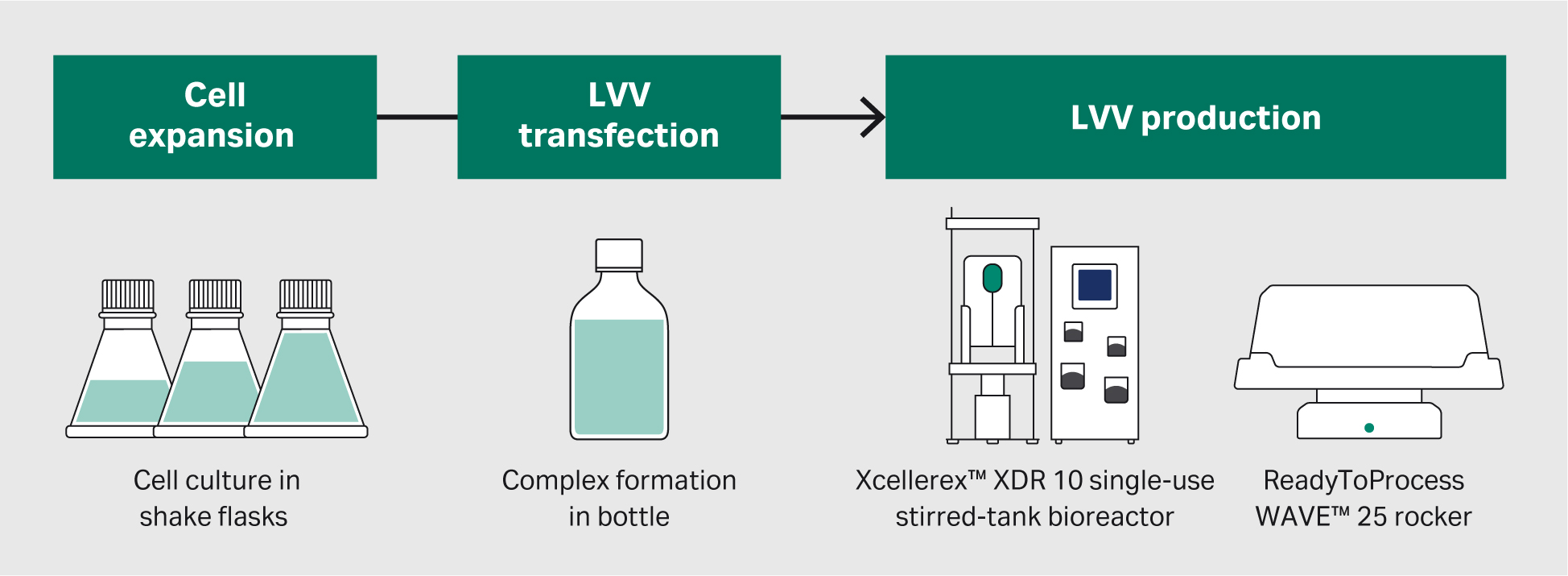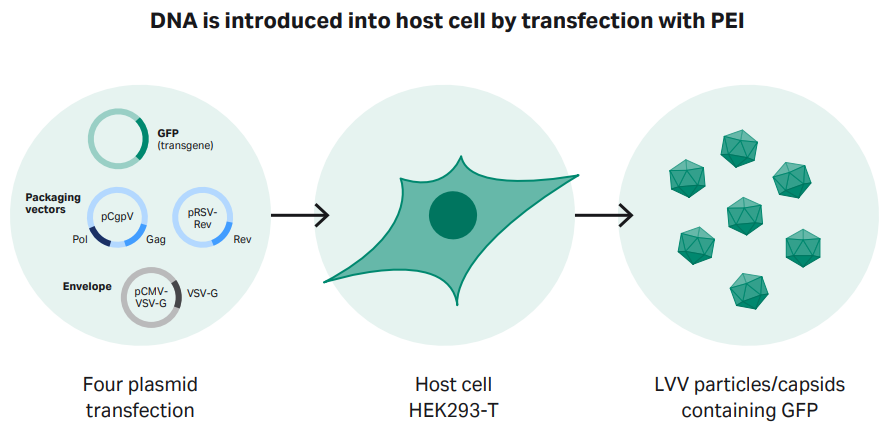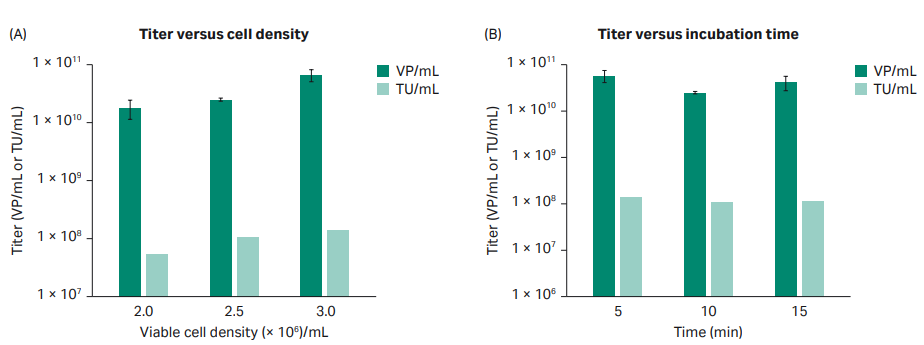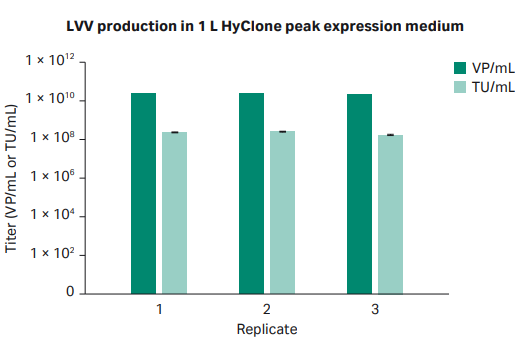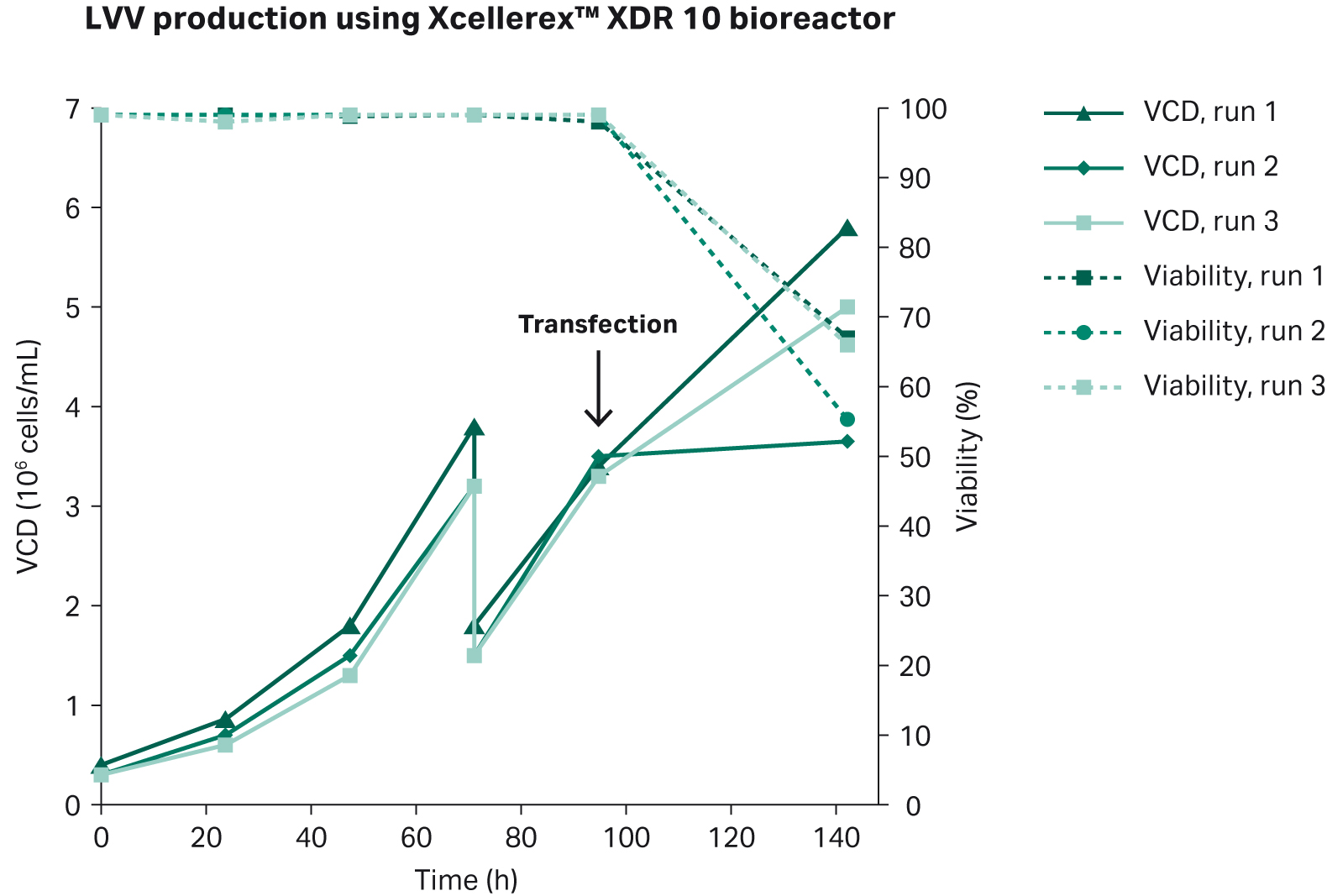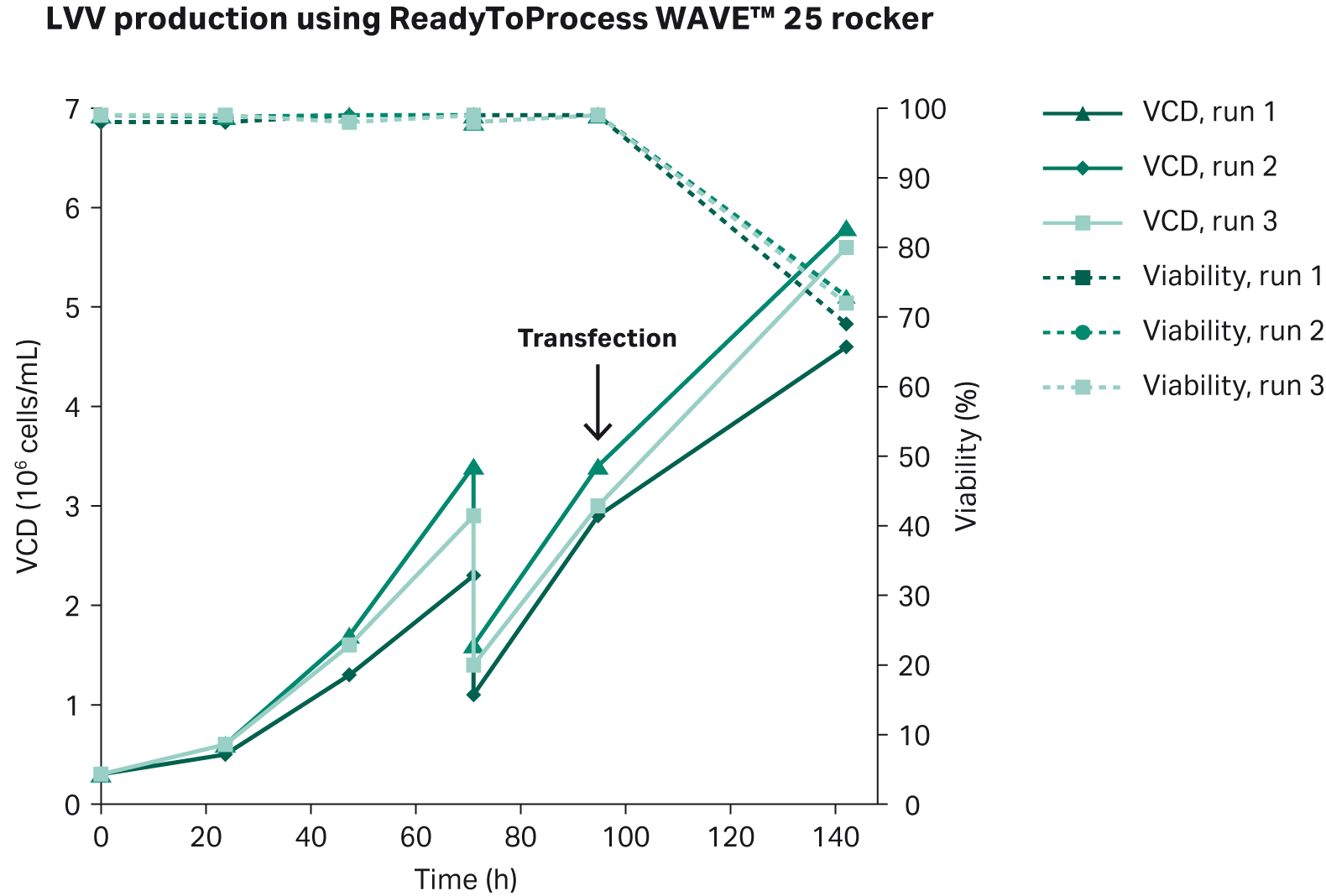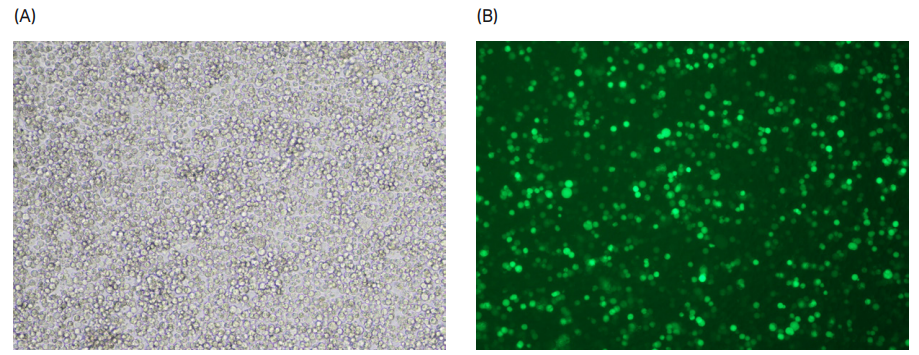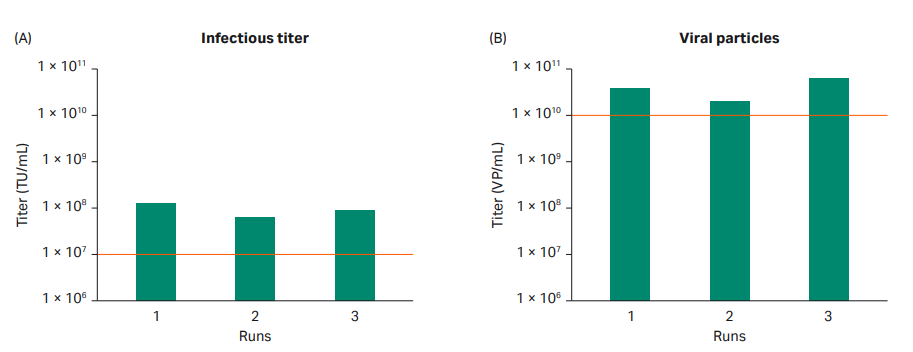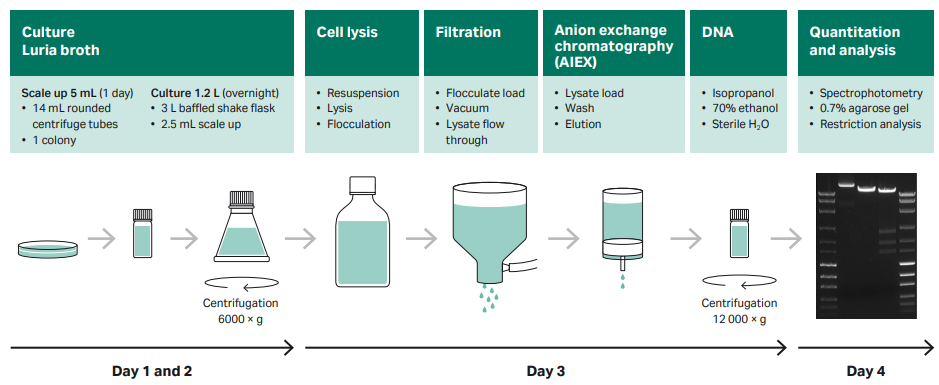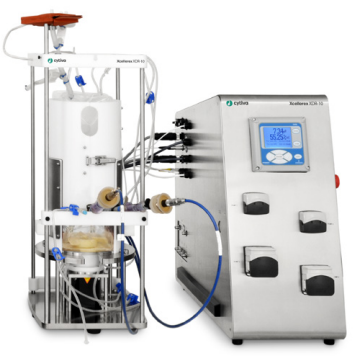Lentivirus (LV) is an enveloped RNA virus that is characterized by its ability to incorporate viral RNA into host cell DNA. For this reason, LV vectors (LVV) are used in the cell and gene therapy field for delivery of nucleic acids into target cells both ex vivo and in vivo. Vector production is one of the major contributors to overall manufacturing costs for cell and gene therapies. Therefore, improvements in vector production, such as increased vector yield per batch, are of high importance as it can reduce manufacturing costs and improve the availability of therapies.
We have developed a scalable and robust upstream process for lentiviral vector (LVV) production of HEK293T cells using ReadyToProcess WAVE™ 25 rocker and Xcellerex™ XDR 10 single-use stirred-tank bioreactor. We describe how to expand HEK293T suspension cells from cryovials to small cell culture in shake flasks and up to a 10 L bioreactor culture. The process was closed and based on serum-free culture in HyClone™ peak expression medium. LVV was produced at high titers upon transient plasmid transfection in the bioreactor.
Introduction
In recent years, there has been a shift from adherent culturing towards serum-free suspension conditions to improve cell culture processes. Here, we utilized a design of experiment (DoE) methodology to optimize LVV production of a HEK293T suspension cell system and we performed the experiment in separate stages:
- First, we used DoE to evaluate the transfection protocol in shake flask, this allowed us to evaluate the impact of multiple factors key to scaling LVV production up, such as plasmid concentration, cell densities, and harvest time.
- Next, we performed LVV production in ReadyToProcess WAVE™ 25 rocker or Xcellerex XDR 10 single-use stirred-tank bioreactor using the protocol established in the first part.
An efficient, robust scalable cell culture process for LVV production was verified by triplicate runs using ReadyToProcess WAVE™ 25 rocker and Xcellerex™ XDR 10 bioreactor system for LVV production.
We performed the production process in different steps (Fig 1):
Fig 1. An overview of the LVV production process. We will discuss the cell culture and transfection process development in this article.
To produce LVV, we used a four plasmid transfection system (Cell Biolabs) consisting of two packaging vectors, one envelope vector, and a transfer vector carrying the green fluorescent protein (GFP) reporter gene, along with PEI MAX (Polysciences) transfection reagent. PEI creates positively charged complexes with plasmid DNA that enters the cell via endocytosis and delivers the DNA into the nucleus, resulting in gene expression of the exogenous DNA (Fig 2).
Fig 2. Transient transfection of HEK293T cells using a four-plasmid transfection approach. Polyethyleneimine (PEI) forms a complex with DNA, which is then introduced into the host cells.
Detailed Materials and methods are found at the end of this article.
Results
Adaptation of HEK293T cells to a serum-free process for LVV production
First, we adapted adherent HEK293T cells to HyClone™ peak expression cell culture transfection medium. Adaptation was performed by transferring cells grown in classical HyClone™ DMEM medium with high glucose supplemented and 10% HyClone™ Fetal Bovine Serum (FBS) directly into the new transfection medium. HyClone™ peak expression medium is ready-to-use and contains stable L-glutamine and poloxamer 188. The cell growth and morphology of the HEK293T suspension cells were evaluated visually over 10 passages. Finally, we created research and working cell banks (RCB and WCB, respectively) from cryopreserved cells grown in the HyClone™ peak expression medium.
Plasmid constructs for LVV process development
Amplification of plasmids for LVV production was performed by transforming bacteria with plasmids. The plasmid DNA was subsequently replicated upon culturing the transformed bacteria. By using a plasmid purification kit, plasmid DNA was retrieved from the harvested material.
Optimized LVV production protocol using HEK293T suspension cells
The DoE study was designed as a full factorial design, including five parameters (VCD, incubation time, enhancer concentration, enhancer time, and DNA concentration), to evaluate the optimal conditions for transfection. During our process development, the goal was to achieve the following criteria: 1010 virus particles (VP/mL) and 107 transducing units (TU/mL).
It was found that all conditions resulted in a viral titer that exceeded the acceptance criteria set for the project.
Instead of performing the additional DoE needed to resolve the curvature for the VCD, a simple additional experiment was carried out where only three different VCD and incubation times were tested with all other parameters set according to results from the DoE. The results from the experiment concluded that the cell density should be 3 × 106 viable cells/mL and that the incubation time should be 5 min to maximize titer (Fig 3).
Fig 3. Evaluation of VCD and incubation time. All flasks evaluated for VCD had a DNA-PEI complex incubation time of 10 min. All flasks evaluated for incubation time had a VCD of 2 × 106 cells/mL.
Optimized transfection protocol
After the initial DoE study had been performed, a protocol was designed for production of LVV based on the results (Table 1).
Table 1. Final parameters used for the transfection protocol
| Transfection parameters |
|
|---|---|
| Cell line | HEK293T, suspension adapted |
| Cell culture medium | HyClone™ peak expression |
| Transfection reagent | PEI MAX 40k |
| Plasmid Ratio | 1:1:1:3 (1 pRSV-Rev: 1 pCMV-VSV-G: 1 pCgpV: 3 pGFP) |
| VCD at transfection (viable cells/mL) | 3 × 106 |
| DNA (µg/mL) | 1 |
| DNA:PEI ratio (µg:µL) | 1:2 |
| Transfection solution incubation time (min) | 5 |
| Sodium butyrate addition (h post transfection) | 5 |
| Sodium butyrate concentration (mM) | 10 |
| Time of harvest (h post transfection) | 72 |
To confirm the transfection protocol for LVV production, 1 L of LVV was produced in triplicate in shake flasks using HyClone™ peak expression medium. The virus titer in the harvest material was above the acceptance criteria for all replicates, and in addition, the variance between replicates was small (Fig 4).
Fig 4. Infectious and viral particle titer from production of 1 L LVV in shake flasks using HyClone™ peak expression medium.
Production in Xcellerex™ XDR 10 single-use stirred-tank bioreactor
First, HEK293T cells were expanded in shake flasks to produce sufficient cells for an inoculation at a cell concentration of 0.4 × 106 cells/mL in a 5 L starting volume for the Xcellerex™ XDR 10 single-use stirred-tank bioreactor. Xcellerex™ XDR 10 bioreactor was set up for inoculation and growth of HEK293T suspension cells to a density of approximately 3 × 106 cells/mL. Cells were diluted by addition of HyClone™ peak expression medium after 72 h to reach approximately 9.2 L.
Transfection was performed 96 h post inoculation and according to our optimized protocol. The transfection complex solution was added to the bioreactor with a final bioreactor volume of 10 L and a cell concentration of 3 × 106 cells/mL. After 5 h post transfection, an addition of Sodium Butyrate was done at a final concentration of 10 mM. Harvest was done 72 h post transfection.
The results from the three production batches in Xcellerex™ XDR 10 bioreactor are shown in Figure 5. All three production runs met the acceptance criteria for viral titer, although difference between runs could be observed. Notably, the largest difference between runs can be observed at the time of harvest, and the reason for one run displaying a lower cell density is most likely due to sampling at harvest.
Fig 5. Cell growth and viability in triplicate production runs of LVV in Xcellerex™ XDR 10 bioreactor. Transfection was done 96 h post inoculation, and harvest was done 72 h post transfection.
To confirm transfection efficiency in the Xcellerex™ XDR 10 bioreactor, we performed brightfield and fluorescent microscopic evaluation of cells in addition to flow cytometry analysis. Figure 6 shows GFP-positive fluorescing cells in diluted sample of LVV at harvest.
Fig 6. (A) Bright field and (B) fluorescent microscope images of LVV at harvest from Xcellerex™ XDR 10 bioreactor.
The production batches gave similar viral titers, with approximately 1010 VP/mL and 107 TU/mL in all three production batches (Fig 7). The consistency between all three batches indicated that the process design was robust and suitable for manufacturing purposes.
Fig 7. Viral titer from triplicate production runs of LVV using Xcellerex™ XDR 10 bioreactor. The acceptance criteria for the project are highlighted with dotted red lines. All production runs met the acceptance criteria.
Production in ReadyToProcess WAVE™ 25 single-use bioreactor
Finally, we used ReadyToProcess WAVE™ 25 rocker for the production of 5 L of LVV. HEK293T cells were expanded in shake flasks to produce an inoculation cell concentration of 0.3 × 106 cells/mL in a 2.5 L starting volume. Then, the ReadyToProcess WAVE™ 25 bioreactor was set up for inoculation and growth of the HEK293T suspension cells to a density of approximately 3 × 106 cells/mL. Cells were diluted by addition of HyClone™ peak expression medium after 72 h to reach a volume of approximately 4.8 L.
Transfection was performed 96 h post inoculation according to our optimized protocol. The transfection complex solution was added to the bioreactor with a final bioreactor volume of 5 L and a cell concentration of 3 × 106 cells/mL. After 5 h post transfection, an addition of sodium butyrate was done at a final concentration of 10 mM. Harvest was performed 72 h post transfection. The results from the three production batches in ReadyToProcess WAVE™ 25 rocker is shown in Figure 8.
Fig 8. Cell growth and viability of triplicate production runs of LVV using ReadyToProcess WAVE™ 25 rocker bioreactor system. Transfection was done 96 h post inoculation, and harvest was done 72 h post transfection.
To confirm transfection efficiency in the ReadyToProcess WAVE™ 25 rocker, we performed brightfield and fluorescent microscopic evaluation of cells in addition to flow cytometry analysis. Figure 9 shows GFP-positive fluorescing cells in diluted sample of LVV at harvest.
Fig 9. (A) Bright field and (B) fluorescent microscope images of LVV at harvest from the ReadyToProcess WAVE™ 25 rocker.
The production batches gave a similar viral titers, with approximately 1010 VP/mL and 107 transducing units (TU/mL) in all three production batches (Fig 10).
Fig 10. Viral titer results from triplicate production runs of LVV in ReadyToProcess WAVE™ 25 rocker. The acceptance criteria for the project are highlighted with dotted red lines. All production runs met the criteria.
Conclusions and discussion
We have presented a scalable and robust upstream process for LVV production with Hyclone peak expression medium using HEK293T cells in suspension, ReadyToProcess WAVE™ 25 rocker and Xcellerex™ XDR 10 single-use stirred-tank bioreactor. In addition, we have shown:
- Each production run met our acceptance criteria set for the titer in the harvest material (≥ 1010 VP/mL and ≥ 107 TU/mL).
- The protocol also showed scalability from small-scale in shake flasks up to 10 L scale in the Xcellerex™ XDR 10 bioreactor.
Adaptation of HEK293T cells to a serum-free process and cell culture for LVV production
We adapted adherent HEK293T cells to suspension culture in our HyClone™ peak expression medium. The HEK293T suspension cells were routinely passaged/subcultured two times per week with a seeding density of 0.2 × 106 cells/mL. Cell culture was performed in 250 mL shake flasks with a working volume of 40 mL. Cells were counted using Vi-CELL cell analyzer (Beckman Coulter) and seeded in a new shake flask with fresh medium (E125/E250 flasks).
Cell culture adaptation protocol
Direct adaptation was performed according to the following step-by-step protocol:
1. Adherent cells were detached and centrifuged at 150 × g for 5 min. Cells were resuspended by thorough mixing in a 5 or 10 mL pipette approximately 20 times.
2. Cells were seeded at 0.3 × 106 cells/mL to 40 mL in a 250 mL shake flask.
3. Cells were split every second day. The pellet was resuspended to keep the viable cell density (VCD) below 2.0 to 2.5 × 106/mL to avoid aggregates. A 40 µm mesh was used during filtration to remove aggregates.
4. VCD and morphology were monitored and NucleoCounter® NC200 Automated Cell Counter (Chemometec) was used for counting aggregates.
5. A working cell bank (WCB) was created after 10 passages using 15 × 106 cells/vial.
Plasmid preparation and purification
The four-plasmid constructs for transfection in this study — pRSV-Rev Packaging, pCMV-VSV-G Envelope, pCgpV Packaging, and pLenti GFP— were sourced from Cell Biolabs. The plasmids were prepared for transfection, sequenced, amplified in bacteria, and purified using a plasmid purification kit.
The plasmid was purified using either EndoFree Mega Plasmid Kits (Qiagen) or Macherey-Nagel NucleoBond PC 10000 EF kits. For specific procedures, see supplier instructions. Each plasmid pellet was dissolved in 0.75 mL sterile dH2O.
We evaluated plasmid quality using restriction enzyme digestion and the fragments were analyzed on an agarose gel (Fig 11).
Fig 11. An example image displaying the QC of two different preps of plasmid (GFP lentiviral control vector). A reference ladder is visible in the first lane from the left, and the uncut plasmid in the second, where the open circular fraction (top band) and supercoiled fraction (bottom band) can be observed. The third and fourth lanes display the linearized and double digested fragments respectively. This was repeated for the second prep.
An overview of preparation using Luria broth (LB), shake flasks, and purification kit is shown in Figure 12.
Fig 12. Overview of preparation using LB, shake flasks, and purification kits.
Transfection
LVV was produced through transient transfection of HEK293T cells using a four-plasmid system with PEI MAX (Polysciences), enabling production of functional LVV particles only in cells transfected with all four plasmids.
The DNA solution was first mixed in transfection solution, 5% of final production volume in a sterile glass bottle. After, the PEI reagent was added to the transfection solution mixture while gently swirling the transfer bottle.
The PEI/DNA transfection solution was incubated at room temperature for 5 min to form DNA complexes. During incubation, the transfer bottle with the PEI/DNA mix was connected by welding the tubing to the bioreactor. An overpressure was created in the transfer bottle to transfer the transfection mix slowly into the bioreactor.
After 72 h post transfection, samples from the bioreactor were collected and analyzed using flow cytometry to determine transfection efficiency. Samples were taken and centrifuged at 850 × g for 10 min. An aliquot was prepared to be analyzed by p24 assay for viral particles titer, and by transduction assay for functional titer. The final transfection protocol and parameters are described in Table 2.
Table 2. Final parameters used for the transfection protocol
| Parameters for LVV production |
|
|---|---|
| VCD (× 106/mL) | 3 |
| DNA concentration (total DNA) | 1 µg/mL |
| DNA ratio | 1:1:1:3 (1 pRSV-Rev:1 pCMV-VSV-G:1 pCgpV:3 pGFP) |
| DNA/PEI ratio (µg:µL) | 1:2 |
| Transfection solution volume (% of total volume) | 5 |
| Transfection incubation time | 5 min |
| Transfection incubation temperature | Room temperature |
| Sodium butyrate addition (post transfection) | 5 h |
| Sodium butyrate concentration (mM) | 10 mM |
| LVV production temperature | 37°C |
| Time of harvest (post transfection) | 72 h |
Using the optimized parameters in Table 2, the transfection protocol for production of LVV in the bioreactors was as follows:
- Day 0: The bioreactor was inoculated with HEK293Tcell suspension at 0.3 × 106 cells/mL in 50% of the final culture volume.
- Day 3: Fresh media was added to 95% of the final volume at a cell density of approximately 1.5 × 106 cells/mL.
- Day 4: The target cell density at transfection was 3 × 106 viable cells/mL. The DNA solution at μg/mL of total DNA was first mixed in transfection solution, 5% of final production volume in a sterile glass bottle. After, the PEI reagent was added to the transfection solution mixture at a 1:2 ratio (DNA/PEI) while gently swirling the transfer bottle. The DNA/PEI transfection solution was incubated at room temperature for 5 min to form DNA complexes. At the end of this incubation time, the bottle was connected to the bioreactor and the DNA/PEI transfection solution mix added. Sodium butyrate was added to the reactor 5 h post transfection to a final concentration of 10 mM.
- Day 6: 72 h post transfection, the bioreactor was sampled and analyzed for transfection efficiency (GFP-positivity) using flow cytometry. Cells were diluted 1:2 in 4% buffered formaldehyde for flow cytometry analysis. Cell morphology and GFP-positivity were also evaluated through microscopy. Cell density, viability, and aggregates were measured using the NucleoCounter® NC200 Automated Cell Counter (Chemometec) . Harvest material from the reactor was clarified through centrifugation at 850 × g for 10 min. Samples were aliquoted for analysis, p24-assay (VP/mL) and transduction assay (TU/mL), and stored at -80°C.
Xcellerex™ XDR 10 single-use bioreactor system settings
Fig 13. The single-use Xcellerex™ XDR 10 is a flexible, stirred-tank bioreactor system suitable for use in process development, small-scale production, and process troubleshooting.
Parameter settings for the Xcellerex™ XDR-10 bioreactor for production of 10 L of LVV are described in Table 3. The pH setpoint was set to 7.1 and controlled by CO2 and NaHCO3 using system default proportional–integral–derivative (PID) settings. DO set point was 40% and controlled by oxygen-enriched air, using the system default PID control settings.
Table 3. Settings for the Xcellerex™ XDR-10 bioreactor 10 L production run
| Parameter |
Xcellerex™ XDR 10 bioreactor settings |
|---|---|
| Production media | HyClone™ peak expression |
| Starting viable cell concentration | 0.3 × 106 viable cells/mL |
| Filling volume | 4 L |
| Inoculation volume | 5 L |
| Transfection mixture | 500 mL |
| Operating volume | 5 to 10 L |
| Impeller/rocker speed | 140 rpm, up pumping |
| Temperature | 37°C |
| pH set point | 7.1 (controlled by CO2 and base) |
| pH PID settings | SeeTable 4 |
| Base for pH control | 7.5% (w/v) NaHCO3 |
| Dissolved oxygen (DO) set point | 40% (controlled by oxygen enriched air) |
| DO PID settings | SeeTable 5 |
| Spargers | 1 mm, 2 µm: Air, O2, CO2 |
| Oxygen flow | PID controlled |
| Carbon dioxide flow | PID controlled |
| Antifoam | 10% Antifoam C emulsion (as needed) |
Table 4. PID settings for PH control
| P (proportional) | 5.00 |
| I (integral) | 1.50 |
| D (derivate) | 0.00 |
| DB (dead band) | 0.05 |
Table 5. PID settings for DO control
| P (proportional) | 0.50 |
| I (integral) | 5.00 |
| D (derivate) | 0.00 |
| DB (dead band) | 0.05 |
ReadyToProcess WAVE™ 25 bioreactor settings
Fig 14. The ReadyToProcess WAVE™ 25 rocker features integrated temperature sensors and load cells, designed for convenient handling and control of cell cultures up to 25 L.
ReadyToProcess WAVE™ 25 bioreactor was prepared and run according to the user manual and checklist. The bioreactor used in this experiment consisted of the following components:
- One ReadyToProcess WAVE™ 25 rocker
- One ReadyToProcess™ CBCU
- One 50 L Cellbag™ bioreactor
- UNICORN™ software
The bioreactor settings are listed in Table 6. Before inoculation, the 10 L Cellbag™ bioreactor was inflated with air and 1.5 to 2 L of HyClone™ peak expression cultivation media was added aseptically to the bioreactor via one of the ports on the bag. Equilibration was performed overnight at 37°C and 5% CO2. The agitation settings were 15 rpm during equilibration. Before cell inoculation, an offset calibration of pH was performed.
Table 6. Summary of the parameter settings used for LVV production in ReadyToProcess WAVE™ 25 rocker
| Parameter |
ReadyToProcess WAVE™ 25 rocker settings |
|---|---|
| Medium | HyClone™ peak expression |
| Starting viable cell concentration | 0.3 × 106 viable cells/mL |
| Starting volume | 1.5 to 2 L |
| Inoculation volume | 2.5 L |
| Operating volume | 2.5 to 5 L |
| Rocking motion | 15 to 27 rpm |
| Angle | 8º |
| Temperature | 37°C |
| Gas flow | 0.3 to 0.4 L/min |
| pH set point | 7.1 (controlled by CO2) |
| Base for pH control | N/A |
| DO set point | N/A (Not needed due to short culture time) |
| O2 | 21% |
| CO2 | CO2concentration in gas mix can be controlled between 0% and 15% and measured between 0% and 20%, regulated according to pH |
pH (offline)
Offline pH measurements were performed with Seven Compact S210 (Mettler Toledo). The pH meter was calibrated every day with three-point calibration using pH calibration buffers. The online (reactor) value was adjusted if the difference to the offline value was ≥ 0.1.
Morphology
Cell morphology and GFP positivity was visually monitored using Nikon Eclipse TE2000e inverted microscope, with bright field for cell morphology and fluorescence filter for detection of cells expressing the green fluorescent protein.
Flow Cytometry
Flow cytometry is used to rapidly analyze large numbers of individual cells or particles in suspension for different physical, chemical, or fluorescent characteristics. It can be used in numerous applications, for example, assessing viability, transfection efficiency, virus production, protein expression, or cell differentiation. Here, flow cytometry was used to evaluate the transfection efficiency, since transfected cells express GFP. This is, however, only an indication of the fraction of cells transfected with the GFP-plasmid, and results do not necessarily correlate with viral titer in the produced material, as all four plasmids are required to be present in a cell for production of functional LVVs.
Transduction assay
The purpose of the transduction assay was to evaluate the functional titer in produced LV material. A predetermined number of adherent HEK293T cells were incubated with viral material, resulting in the expression of GFP in transduced cells. 48 h post transfection, GFP-positive cells were measured through flow cytometry and by analyzing the percentage of GFP positive cells in the population, and estimation of transducing units/mL (TU/mL) in the viral material could be calculated.
The transduction assay was performed according to the following steps:
Day 1: 96-well plates were seeded with cells at a determined density, 8 wells for each viral sample to be tested. Extra wells for controls were also seeded. The plates were incubated for 3 h at 37°C, 5% CO2, humidified conditions. After the incubation time viral supernatants were thawed and prepared by serial dilution in fresh complete media supplemented with gentamycin (50 µg/mL) to a final sample dilution of 1:10, 1:100, 1:1000, and 1:10 000. Media was removed from all remaining wells and fresh complete media containing 8 µg/mL polybrene and gentamicin (50 µg/mL) was added to each well. The previously prepared viral supernatant dilutions were added to the corresponding wells in plates, while complete media was added to the negative control wells. Plates were incubated overnight at 37°C, 5% CO2, humidified conditions.
Day 2: Pre-warmed complete media was added to each well to a final volume of 200 µL. Plates were incubated at 37°C, 5% CO2, humidified conditions.
Day 3: Cells were detached using trypsin and mixed 1:2 with 2% formaldehyde before analyzing through flow cytometry.
First, a negative control was used to adjust the acquisition settings on the flow cytometer. When the acquisition settings had been chosen, a histogram in the GFP detection channel was created and a gate for GFP-positivity was set so that 0.1% of the negative population fell within this gate. 10 000 to 20 000 live cells were recorded for each sample. The fraction of GFP-positive cells in the transduced samples was used to calculate the viral titer in transducing units/mL (TU/mL) according to the following formula:
p24 assay
p24 Titer Kit (Lentivirus Associated HIV p24) from Gyrolab is an immunoassay developed for detection and quantitation of the lentivirus associated HIV-1 p24 protein. The kit is based on a sandwich assay that uses a biotinylated anti-p24 capture antibody and a fluorescence-labeled detection anti-p24 antibody. The immobilized capture antibody binds p24 in samples. Bound p24 was then detected through the fluorescence labelled antibody in the Gyrolab Evaluator (Gyrolab Xplore). All samples are both run untreated to determine the free p24 and then treated with a detergent to lyse viral membranes and release the virus associated p24. The results were calculated using the following formula:
CY39452-20Dec23-AN
